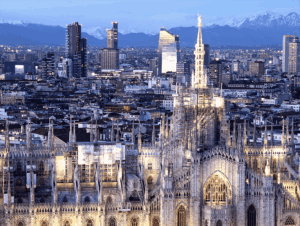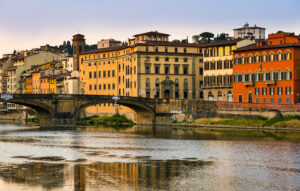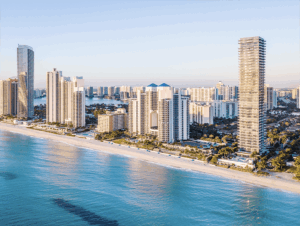As Florence’s cultural renaissance continues to drive premium real estate demand, savvy investors are turning to established agencies like Columbus International, with our Florence office providing insider access to Tuscany’s most coveted properties and investment opportunities in this UNESCO World Heritage market.
Contact us: info@columbusintl.com
After nearly a decade of closure, one of Italy’s most extraordinary architectural marvels offers unprecedented after-hours access—and signals Florence’s continued evolution as a world-class cultural and investment destination.
Florence’s most exclusive walkway is finally welcoming visitors back—and doing so with a twist that would make even the Medici proud. The Vasari Corridor, the remarkable 16th-century elevated passageway that spans over 700 meters above the heart of Renaissance Florence, has launched special evening tours every Friday from 7:00 PM to 11:00 PM, running through December 26, 2025.
This isn’t just another tourist attraction reopening. The Corridor represents one of the most audacious architectural achievements of the Renaissance—a private skyway commissioned by Cosimo I de’ Medici and completed in an astonishing five months in 1565. Built by Giorgio Vasari (the same architect behind the Uffizi Gallery), this “aerial tunnel” was designed to allow the Medici family to travel safely and discretely between their residence at Palazzo Pitti and the seats of power at Palazzo Vecchio and the Uffizi, without ever setting foot on Florence’s notoriously unsanitary streets.
A Monument Restored to Its Original Purpose
The evening access program, which began July 4, represents more than just expanded visiting hours—it’s a return to the Corridor’s essential character. After closing in 2016 for extensive safety upgrades and restoration, the passage has been stripped of the 700+ paintings that previously lined its walls, including a renowned collection of self-portraits. Instead, visitors now experience what Uffizi Director Simone Verde calls the Corridor’s “original nudity”—a simple but extraordinary walkway suspended above one of the world’s most beautiful cities.
The strategic decision to remove the artwork transforms the experience entirely. Rather than competing for attention with Renaissance masterpieces, visitors can focus on what the Medici themselves would have seen: unparalleled views of Florence through 73 newly opened windows that line the route. The Corridor now functions as it was originally intended—as a spectacular elevated promenade offering unique perspectives of the Arno River, Ponte Vecchio, and the historic center.
Premium Access at Accessible Prices
The economics of the evening tours reflect sophisticated cultural programming. At €20 for regular admission (€2 for reduced tickets), the pricing remains remarkably accessible for what amounts to one of Europe’s most exclusive architectural experiences. The mandatory advance booking system, with time slots running every 20 minutes from 7:00 PM to 9:50 PM, ensures crowd control while maximizing access.
Tours begin at the Uffizi Gallery entrance near Piazzale degli Uffizi and conclude at the Boboli Gardens through the Rondò di Bacco gate near Piazza Pitti. While the ticket includes passage through the Uffizi, it specifically excludes gallery visits—a clever operational decision that keeps the focus on the Corridor experience while managing traffic flow.
The Business of Cultural Heritage
The reopening represents a masterclass in heritage site management. By limiting access to Friday evenings only, the Uffizi creates scarcity while providing a premium experience that doesn’t compete with daytime gallery operations. The evening timing also offers something genuinely different—Florence bathed in golden hour light and early evening shadows, viewed from a perspective unavailable anywhere else in the city.
For Florence’s tourism economy, still recovering from pandemic impacts, the Vasari Corridor reopening provides a significant new draw. The experience offers something that luxury travelers increasingly seek: access to spaces and perspectives that feel genuinely exclusive and historically significant.
A Bridge Between Past and Future
The Corridor’s story reflects broader themes in contemporary cultural tourism. Originally built to solve a 16th-century urban mobility problem (how to move the ruling family safely through a crowded, potentially dangerous city), it now addresses a 21st-century challenge: how to provide meaningful cultural experiences that justify both the preservation costs and visitor expectations.
The Medici’s original vision—a private, elevated route offering security and spectacular views—translates perfectly to modern cultural tourism. Visitors today seek the same things the Medici wanted: unique access, elevated perspectives, and the sense of walking through history rather than simply observing it.
The Medici Legacy in Modern Terms
Walking the Vasari Corridor today offers insight not just into Renaissance architecture, but into power, urban planning, and the relationship between public and private space. The Medici didn’t just commission a building; they created a physical manifestation of political authority that literally rose above the everyday life of their subjects.
That same elevation now serves cultural rather than political purposes, but the effect remains powerful. The Corridor transforms visitors into temporary members of Florence’s ruling class, offering the same privileged perspective that once belonged exclusively to one of Europe’s most influential families.
For cultural institutions worldwide grappling with sustainability, accessibility, and relevance, the Vasari Corridor’s evening program offers a compelling model: honor the original purpose, enhance the unique experience, and create access systems that serve both preservation and public engagement.
The Medici built their skyway to move efficiently above Florence’s chaos. Five centuries later, it serves the same function—lifting visitors above the crowded streets to experience one of humanity’s greatest cities from a perspective that remains, quite literally, above it all.



